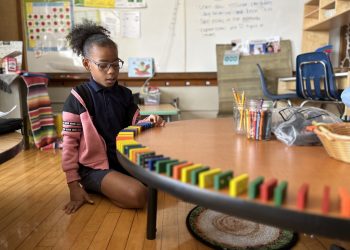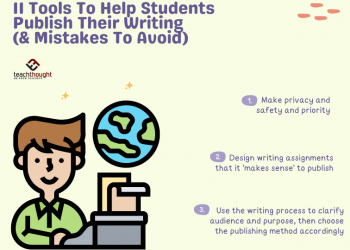Discussions of pedagogy, instructional design, technology integration, and assessment are no longer confined to K-12 teachers. College instructors, in increasing numbers, have begun to think seriously and systematically about how to enhance student learning and engagement, remediate content and skill deficiencies, close achievement gaps, and build upon students’ prior knowledge and skills.
The latest book to suggest how college faculty might draw upon the science of learning to strengthen their teaching and make their classes more inclusive, equitable, effective, and student-centered is Cathy N. Davidson and Christina Katopodis’s The New College Classroom, which offers a wealth of examples of how to make lecture classes less listless and seminars less silent, while making students into more independent, creative, and active learners.
Not another “how to” book, The New College Classroom has a larger objective: To provide striking examples about how innovative junior scholars are designing courses to be more inclusive, interactive, and radically democratic. The book’s goal is two-fold: To draw upon cognitive neuroscience, management coaching, and conflict negotiation theory to explain how instructors can bring all students, not just extroverts or those with steel-trap memories, to success; and how to reduce the time that instructors and students spend on unproductive tasks in order to reduce the burden of high teaching loads.
The book begins with a telling fact: That a study of 12,000 classrooms found that instructors took up 89 percent of class time speaking. Even more striking: Instructor-centered classrooms were nearly as common in seminars and discussion classes as it was in lecture courses. This faculty-centric approach persists even though a growing body of scholarship indicates that active learning improves student performance across virtually every dimension, from scores on standardized tests to knowledge retention and the ability to apply skills and content in new situations.
While acknowledging the power of a great lecture to entertain, motivate, and inspire– and, I’d add, model a scholar at work and effectively organize and efficiently communicate complex information – active learning is what allows a student “to extrapolate that knowledge…and use it to solve problems and make important decisions.” In addition, active learning instills skills that lectures cannot, from critical thinking to collaboration.
The authors then look at a variety of strategies that can make classes more dynamic, interactive, and participatory, and that transform the instructor from performer, sage, demonstrator, role model source of authoritative information into a learning facilitator.
Let me briefly survey the key topics that the book addresses.
Mentoring
“Teaching,” Davidson and Katopodis contend, “is mentoring.” It involves sharing success strategies, providing encouragement and advice (while maintaining healthy personal boundaries), and teaching students how to mentor themselves. The authors offer thoughtful, practical advice how faculty members should present themselves to students, prioritize student wellness, empower students, and best to support students who experience sexual harassment or racial discrimination or who have cognitive or physical disabilities.
Participatory Course Planning
The authors champion the idea that students should actively participate in a course’s design. “Cocreation,” they declare, “is colearning.” Students with a stage in the course’s design will, they argue, invest more energy, thought, and attention to the class.
As an admittedly extreme example, they suggest that students might co-create the course syllabus, choosing problems or questions that a course segment might focus on, discussing the kinds of assignments and projects that will be required, and providing input into the class’ grading policies. Then, there’s a middle ground, in which the instructor determines the course’s core topics, but allows students to choose from an array of optional topics and various possible assessment methods.
The authors are particularly concerned that course workloads are unrealistic, given the other demands on students’ time. When instructors over-assign homework or projects, students inevitably respond by skimming, bluffing, cramming, and sometimes cheating. The authors urge faculty members to using a tool to estimate the time it takes for students to complete the assigned work.
The authors also emphasize the importance of building formative reflections into the course so that the instructor can get timely feedback about pace, workload, content, activities, and other topics, and make appropriate mid-course corrections.
Lesson Planning
Lesson planning, many faculty members believe, is best left to K-12 teachers. Even though instructors might carefully craft a lecture or compile a list of discussion questions, it’s exceedingly rare for faculty to create a detailed daily plan that identifies each session’s intended learning outcomes and specifies what the instructor will impart through direct instruction, guided discussion, and various instructional activities, each with its own time slot.
The authors do believe that college teaching would benefit from greater intentionality in instructional design. The book calls for an opening warm-up, a class agenda that students can contribute to, and time reserved at the end of each class session for review and reflection in order to cement the lessons take-aways into long-term memory.
Engagement Activities
At the book’s core are an array of strategies for actively engaging students in their own learning.
- To ensure that students understand the class’ format and requirements, consider a scavenger hunt that challenges students to find key course information in the syllabus. Or ask students to create a timeline to visually represent the course’s structure. Or have them collaborative annotate and discuss the syllabus.
- Consider asking students to create a class constitution, a set of principles that will help ensure that the class functions as a learning community respectful of diversity and intellectual property.
- Give students opportunities to lead the class, for example, by introducing a class session or leading a discussion.
- Embrace techniques proven to increase student participation in ways that won’t embarrass or stress students. These include Think-Pair-Share (in which students collaboratively solve a problem or answer a question); Entry and Exit Tickets (in which students jot down ungraded, spontaneous responses to a prompt); and Collaborative Note-Taking (using a tool like Google Docs).
Addressing Controversial Topics
The authors express a great deal of concern about ensuring classroom equity, for example, by giving each student two opportunities to speak during a class session or asking students to raise their hand in response to a question then calling on those from marginalized backgrounds first. Collegiality is another source of concern, and the authors describe an “Oops”/”Ouch” technique that encourages a student who feel offended by a remark to say “Ouch” and a student to acknowledge an error by saying “Oops.”
Of course, not all classroom tensions can be sidestepped. Davidson and Katopodis suggest using hot moments as learning opportunities, acknowledging contrasting perspectives, giving students opportunities to be heard, identifying any common points of agreement, and reframing the controversy through a more nuanced, academic lens by incorporating scholarly research into the conversation. Above all, treat the lived experiences of your classroom’s diverse students into learning assets.
Group Work
Convinced that “there is perhaps no skill more crucial…than being able to collaborate with others,” the authors offer a host of tips about how to make group work work. They offer practical advice about how to set expectations upfront and how best to acknowledge the challenges of group work, including how to ensure that all group members participate, divvy up roles, responsibilities, and workloads fairly, keep group members accountable, and ensure productive collaborations in online courses. Above all, the authors stress the importance of recognizing and valuing differences of opinion.
Project-Based Learning
Meaningful project-based learning requires students not to think of the project as a way to fulfill a requirement, but as a genuinely worthwhile pursuit. Therefore, it’s essential that instructors frame a project learning as genuinely meaningful: As a way to solve a mystery or a real-world problem, make a tangible contribution to knowledge, or address omissions or biases in previous research. To keep students motivated and on track, it is essential to break the project into smaller milestones and schedule regular check-ins along the way.
Providing Meaningful Feedback
Among the book’s strongest chapters is one on feedback, which not only underscores the value of timely, formative feedback, but of peer feedback, which benefits the provider as well as the recipient. As the authors make clear, It is important that any feedback be part of a process and be constructive. Develop and discuss rubrics collaboratively. Provide students with checklists and questions they should consider as they work on an assignment or project. Remember: The proper goal of feedback is to offer support and encouragement, heighten students’ self-awareness, and foster growth and improvement. Act like a coach, not a critic.
But feedback is meaningless if students don’t know how to accept and act upon constructive criticism. An instructor needs to help students learn how to accept constructive criticism positively and not defensively or emotionally. Consider discussing common errors with the whole class. Also, consider letting students revise and resubmit work along with a cover letter that explains how they took into account the feedback they received.
Rethinking Grading
The authors cite a host of scholars who question whether grades are objective, meaningful, and motivational, and who argue that grading encourages cheating and actually hinders learning. Indeed, one study found a striking correlation between grade inflation and tuition, and others found that providing written comments on student work without grades is the most effective form of feedback.
Given the importance that parents, students, college administrators, and graduate and professional schools attach to grades, the authors describe a number of options that they regard as fairer. Supplement grading with formative feedback. Consider contract grading, in which letter grades are assigned based on the number of assignments that a student completes acceptably. Let students co-author grading rubrics, identifying the elements that comprise exemplary work, or suggest essay questions.
If colleges are to successful address differences in students’ pre-college preparation, reduce performance gaps, and increase motivation, persistence, and academic success, teaching innovation is imperative. Here’s my advice:
- Identify your students’ learning needs and interests.
Your students will learn more if you tailor your teaching to their needs and interests. Consider a preassessment that will allow you to gauge their interests and level of knowledge and skills. Make sure your students know how to study and read efficiently and effectively. Take steps to bolster their confidence and motivation. Be sure to address knowledge and skills gaps. Also, be cognizant of the ways that the course material might conflict with students’ existing opinions or perspective. - Be transparent about your learning goals.
Share your course objectives and explain how your class’ activities support those goals. - Make your class more engaging.
At the beginning of class, grab your students’ attention with an interesting fact, a mystery, a problem, or a paradox. Explain a topic’s relevance. Motivate your students to complete the reading. Make your class more interactive by asking questions, soliciting opinions, getting students to make short presentations, encouraging discussions, and using audio, video, and other sources to prompt dialogue and debate. Remember, without engagement and motivation there is no learning. - Be clear and well organized.
Structure your class logically. Avoid confusing instructions and explanations. Be wary of cognitive overload – making it difficult for students to process information because you provided too much information at once or required them to undertake too many tasks simultaneously. - Present complex material in multiple ways.
You can reinforce student understanding if you introduce key concepts or content out loud, but also through relevant readings, visually through charts and graphs, and various activities. - Make your class more dynamic.
Embrace your inner John Dewey. Design learning experiences that are interactive and participatory and that involve active learning strategies: case study analysis, debate, discussion, group projects, inquiry and investigation, peer teaching, problem solving, role-paying, and more. Active learning requires students to actively participate in their own learning rather than acquiring information passively. It goes beyond note-taking and memorization by requiring students to actively process information, apply knowledge and skills, construct mental models, and develop their higher order thinking skills, including the ability to apply, analyze, synthesize, generalize, and evaluate. It can be solitary or social and collaborative; it can or cannot be technologically-enhanced. It tends to be skills-focused, rooted in authentic, real-life tasks, and challenges students to do the hard work of presenting and explaining information and solving problems. - Acknowledge the social and affective dimensions of learning.
Learning occurs within a social setting, and can’t be understood without recognizing that complex dynamics of power and emotion are at play. Learning is often a wrenching process that requires students to confront and question prior assumptions and accept their weaknesses and concede their errors. Therefore, it is essential that instructors be attentive and responsive to the emotions that students feel and help them articulate their thinking, confusions, or anxieties. - Provide regular, substantive constructive feedback.
If you want student performance to improve, you must provide timely, meaningful, and actionable feedback. But if that feedback is to be effective, it must be skillfully delivered. Be sensitive; acknowledge the student’s effort, strengths, and progress or improvement. Explain what the student is or isn’t doing effectively and how performance can be improved. Focus on a specific skill; don’t over-comment or nitpick. Above all, avoid using feedback to justify a grade. Instead, be forward looking, describing specific steps the student should take in future work. The purpose of feedback is to educate, not to critique. - Offer opportunities for reflection.
Reflection, or what psychologists call metacognition, can help students accurately assess their performance and gauge what they do and don’t understand. Metacognitive awareness can also help students learn how to self-monitor, correct errors, and transfer knowledge and skills from one context to another. As someone who has directed a teaching and learning center (at Columbia), I can say, without hesitation or reservations, that The New College Classroom is an ideal guide to innovative ways to facilitate and deepen student learning. Everyone who teaches (or hopes to teach) college, will find this book a provocative and stimulating source of ideas about how to make our classrooms more equitable, participatory, and interactive. I can assure you: You’ll come away with a toolkit of techniques – involving active learning, flipped classrooms, gamification, role-playing activities, Socratic, social, and critical pedagogies, and inquiry-, problem-, team-, and project-based teaching strategies – that will not only make you a better, more effective teacher, but which will challenge, stimulate, and inspire your students. That said, I’ve also come to believe that the essential teaching and learning problem that we face, Dear Brutus, lies not merely in pedagogy, but in our failure to embrace other ways to educate students.
Let me suggest, very briefly, a number of alternatives to our standard lecture classes and seminars.
1. A Community of Inquiry
Create a learning experience that is modeled on a social network, where an interdisciplinary community of scholars and students share information and build knowledge about a topic of intense public interest, such as the pandemic or gender, racial, and class disparities.
2. A Solver Community
Assemble a community of scholars and researcher to work collaboratively to address a pressing problem.
3. A Studio or Workshopping Approach
Widely deployed in creative writing and the visual and performing arts, workshopping combines individual presentations, brainstorming, group discussion, and engaged criticism to strengthen students’ projects.
4. Community-Based Instruction
Integrate community engagement and service activities with instruction and reflection in order to tackle a genuine local needs.
5. Practicums and Clinicals
Give students authentic opportunities to engage in professional practice. Typically, practicums and clinicals are confined to such fields as education, mental health counseling, nursing, or social work, but can certainly be extended to archaeology, geology, and a host of other disciplines.
6. Scaled Research
Let undergraduates conduct laboratory, archival, quantitative, qualitative, and other kinds of research under the direction of faculty, post-docs, graduate students, and near peer mentors. This ought to be a three-phase process involving training in research methods, the supervised research experience itself, and the opportunity to present their findings in a public setting.
7. Maker Spaces
Create a collaborative workspace within a department or college, where students, individually or in a group, can, with faculty support, develop a meaning project, taking it from a idea into a finished product.
8. Work-based Learning
Expand access to supervised internships and co-ops where students can acquire genuine career experience while applying academic knowledge and technical skills.
9. Resource Development
Teams of students, under the guidance of a faculty member, collaboratively develop resources for schools, museums, or other cultural and educational institutions.
Yes, we need to improve our pedagogies. Yes, we need to rethink our role and responsibilities as instructors. Yes, we need to become more thoughtful about how to motivate and assess learning. But we also need to break free from the box that assumes that the most valuable learning takes place within a lecture hall or seminar room.
Steven Mintz is professor of history at the University of Texas at Austin.
Source by www.insidehighered.com










